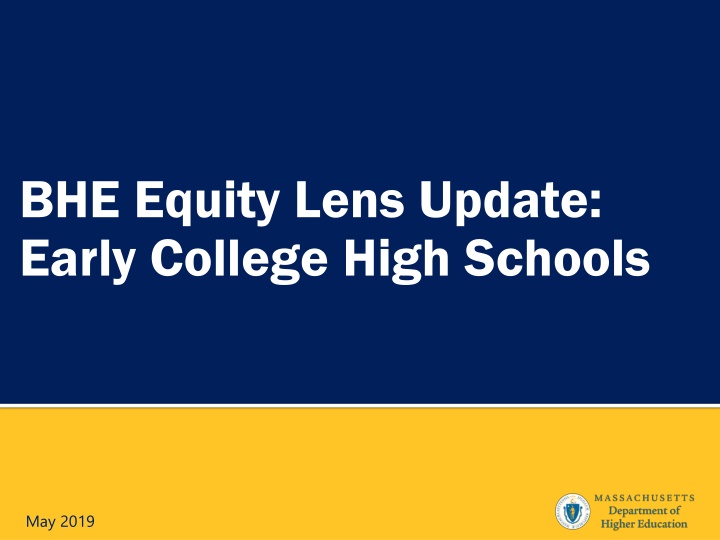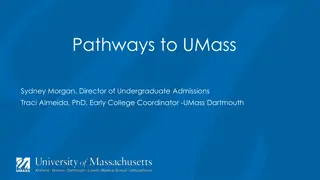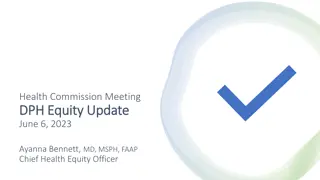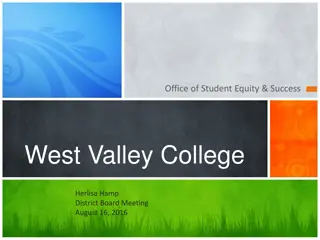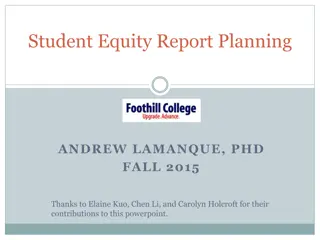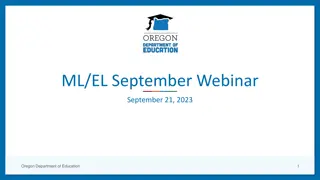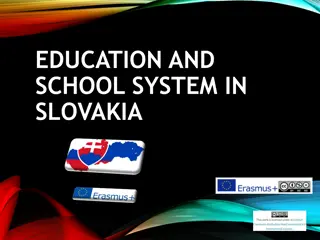BHE Equity lens Update: Early College High Schools
Equity Lens Update on Early College High Schools, including designations, performance evidence, national data, funding status, and strategic plan refresh. Insights on demographics, credits earned, grades, retention rates, and impact of the NC Early College Model.
Download Presentation

Please find below an Image/Link to download the presentation.
The content on the website is provided AS IS for your information and personal use only. It may not be sold, licensed, or shared on other websites without obtaining consent from the author.If you encounter any issues during the download, it is possible that the publisher has removed the file from their server.
You are allowed to download the files provided on this website for personal or commercial use, subject to the condition that they are used lawfully. All files are the property of their respective owners.
The content on the website is provided AS IS for your information and personal use only. It may not be sold, licensed, or shared on other websites without obtaining consent from the author.
E N D
Presentation Transcript
BHE Equity Lens Update: Early College High Schools May 2019
Agenda 1. ECHS Designation Update 2. Some early evidence on ECHS performance 3. Emerging National Data 4. Funding & Legislation Status 5. Refreshing the Strategic Plan for the Early College Initiative 2
ECHS Designation Update Approved a total of 17 ECHS programs now including over 30 high schools; 5 out of 9 state universities; 10 out of 15 community colleges and one private college 3
Early Promising Evidence From an Early College Community of Practice including four of the original seven designated programs (partial sample of the total cohort of designated ECHSs) Demographics of participating students 52% female 68% Hispanic; 9% African-American; 8% white; 11% unknown Credits earned Fall of 2018 mean credits 4.6; Spring mean 4.7 credits Means an average of about 3 courses per student/year Grades earned in Fall 2018 Ranged from A to F; a few W,I, Dropped Among completers, mean GPA 3.9 Persistence/Retention 89.6% across 11th, 11thand 12thgrades 4
THE IMPACT, COSTS, AND BENEFITS OF NC S EARLY COLLEGE MODEL Julie Edmunds, SERVE Center at UNCG Fatih Unlu and Tiffany Tsai, RAND Corporation Elizabeth Glennie, RTI International 6
NORTH CAROLINAS MODEL Small high schools that blur the line between high school and college Mostly located on college campuses Serve students in grades 9-12 or 13 Targeted at students who are underrepresented in college First generation; low-income; minority Goal is to get a high school diploma and two years of college credit/Associate degree 7
Articulated program of study, grades 9-12 or 13 leading to Associate s degree, college readiness activities CollegeReady Academic and affective supports, supportive relationships Powerful Teaching and Learning Personalization High-quality, rigorous, and relevant instruction, ongoing assessment Students Graduating from High School Ready for College Shared leadership, shared vision Purposeful Design Leadership Small size, location on college campus, flexible use of time Professionalism Ongoing professional development, staff collaboration, collective responsibility 8
EXPERIMENTAL STUDY OF THE MODELS IMPACT Funded by three grants from the Institute of Education Sciences Twelve-year experimental study comparing students who applied to and were randomly offered a slot in the ECHS with students who applied for and were randomly turned down Examines the impact of the model on core outcomes: coursetaking, academic performance, behavior, attitudes, dropout, graduation from high school, postsecondary enrollment, college credit attainment, postsecondary performance and postsecondary credentials 9
SAMPLE Students apply and schools do some screening Random assignment within the eligible population Full sample: 19 ECHS, 44 lotteries, 4000 students Cohorts: 2005-06 through 2010-11 Attrition varies across data sources and outcomes: generally low (<10%) and similar between treatment and control groups. Low noncompliance with random assignment: 13% no-shows, 2% crossovers Control students attend business as usual 10
Impact on Postsecondary Credentials: Full Sample Adjusted Impact, ITT estimate Adjusted Treatment Mean Control Mean % Attainment of any postsecondary credential by eight years after 9th grade (N=1671 students) % Attainment of associate degree 37.0 22.2 14.8** 28.4 8.8 19.6** % Attainment of technical credential 2.2 3.0 -0.8 % Attainment of Bachelor s degree 18.1 12.8 5.3** *Significant at p .05; **significant at p .01. 11
% Attaining any Credential--by Subgroup 100 90 80 70 60 50 44.7** 44.4** 43.9** 40.8** 40 31.3** 29.2 29.5* 28.1 26.7 25.5* 30 25.9 17.5 17.3* 15.4 20 15.2 9.8 10 0 Treatment Control *Significant at p .05; **significant at p .01. 12
COST TO AN EDUCATIONAL CREDENTIAL (FROM SOCIETY S PERSPECTIVE) Cost to Early College Pathway Traditional High School Pathway High school diploma (students with maximum of HS diploma only) $32,019 $24,859 HS diploma plus a NC Community College two-year degree $45,762 $48,356 HS diploma plus a UNC system four-year degree $91,192 $121,626 13
GPA IN THE UNC SYSTEMAFTER LEAVING EARLY COLLEGE Adjusted Treatment Mean Unadjusted Control Mean Impact Estimate Cumulative UNC System GPA Through two years after 12th grade (grade 14) Through three years after 12th grade (grade 15) 2.60 2.56 .04 2.62 2.59 .03 2.78 2.71 .06 First semester 14
Funding and Legislation Status EOE Line Item Chapter 70 Proposal Trust Fund Proposal CDEP Funding Legislation 19
Refreshing the Strategic Plan for the Early College Initiative New Position of Early College Director Kristin Hunt Connect Original Intent of EC Initiative, First Generation of Designation Criteria with emerging evidence from pioneer ECHSs, national data and growing Massachusetts ecosystem 20
